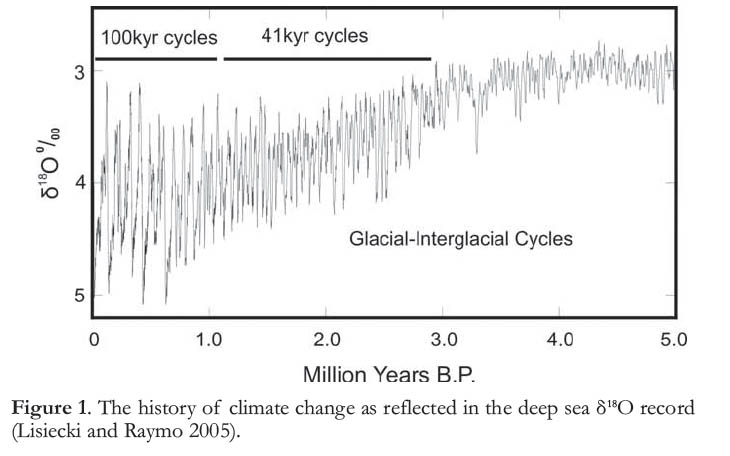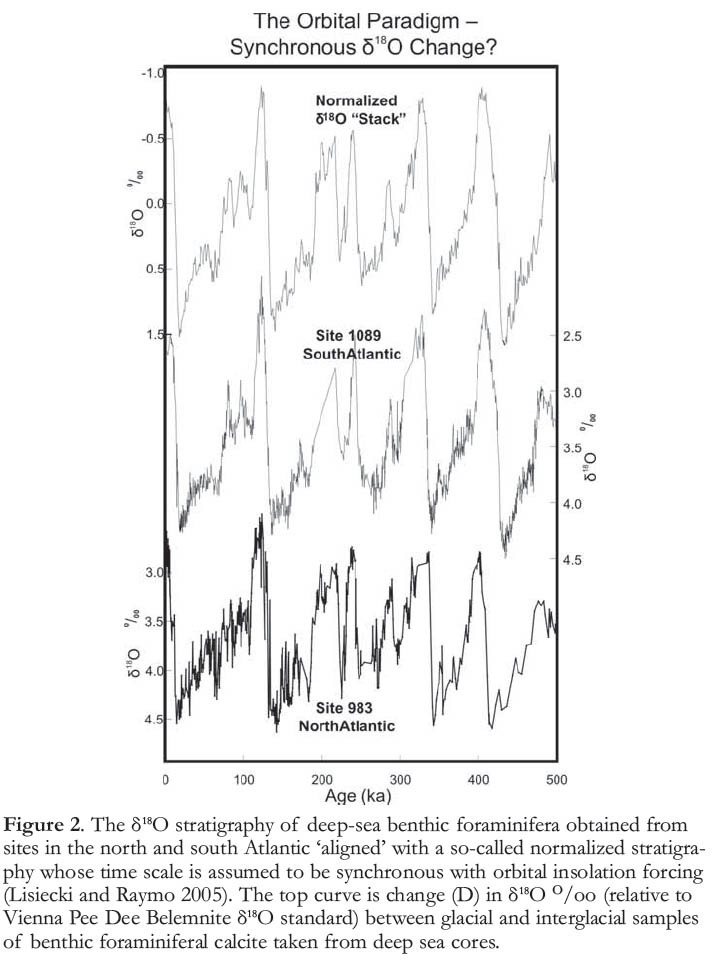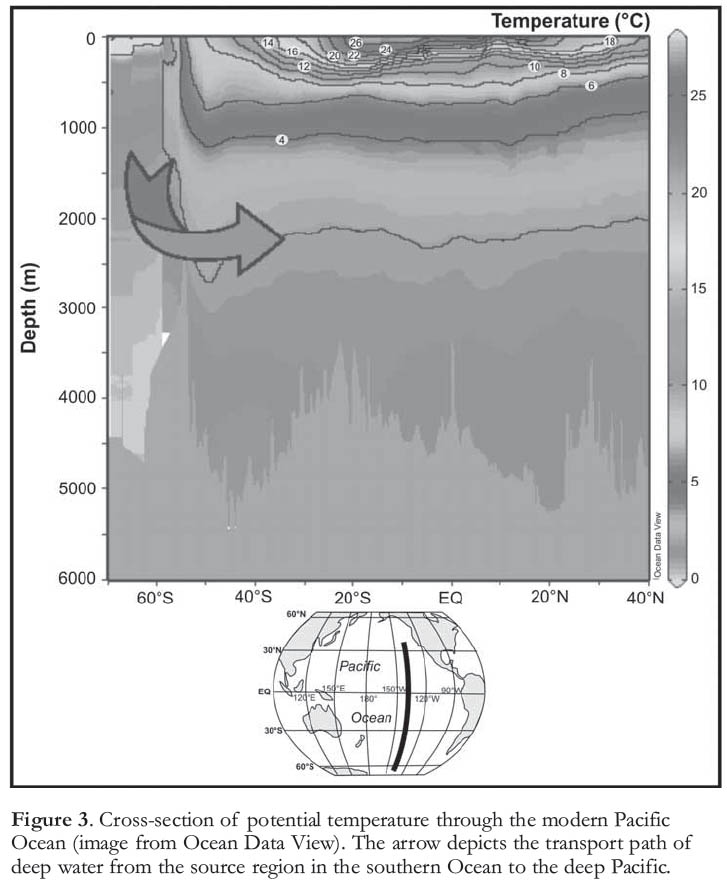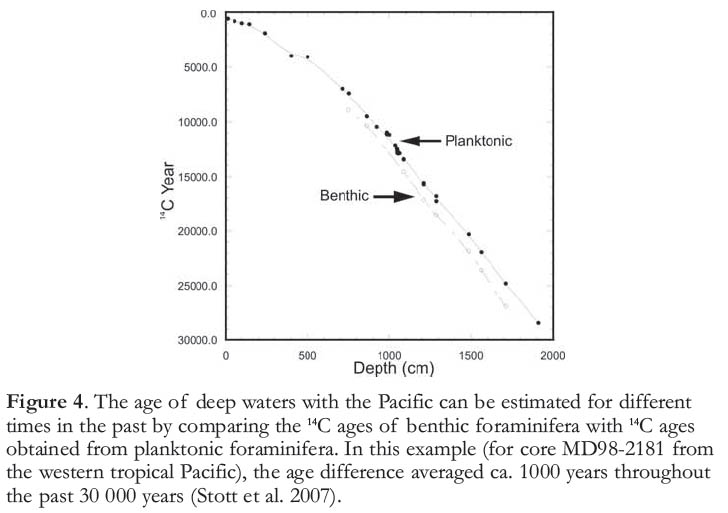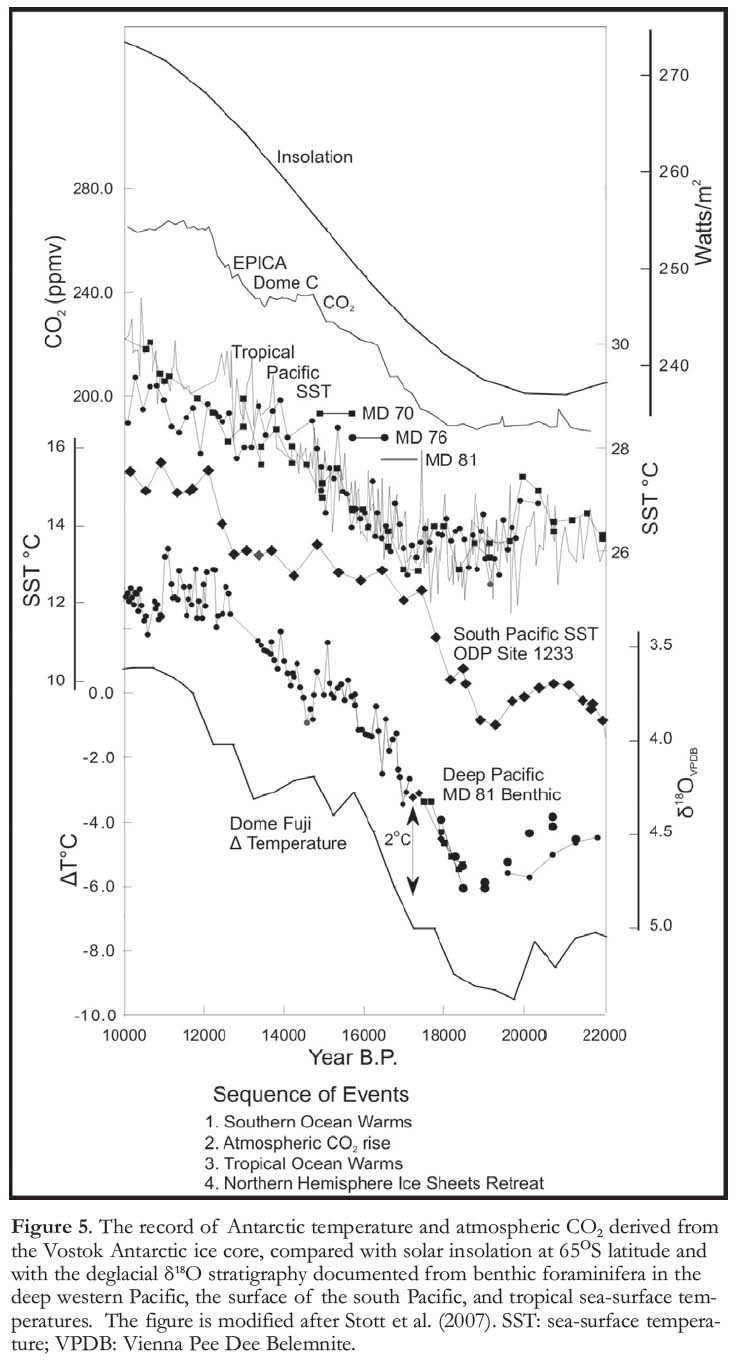Series
The Geoscience of Climate and Energy 7.
The Oceanic Climate Capacitor
Lowell StottDepartment of Earth Science, University of Southern California, Los Angeles, CA, 90089, USA
stott@usc.edu
SUMMARY
In this study, 14C age dating of biogenic carbonates in high-deposition-rate marine sediment cores from the Pacific Ocean is used to establish the relative phasing of low and high latitude ocean warming at the beginning of the last glacial termination. The results indicate the Southern Ocean began to warm as much as 1000 years before deglacial warming began in the western tropical Pacific Warm Pool region. Importantly, it appears that much of the deep Pacific warming occurred between 19 and 14 ky BP, prior to the major deglaciation of the northern hemisphere ice sheets. These results further indicate that d18O stratigraphies from deep sea carbonates are not synchronous throughout the oceans over a glacial/interglacial termination and. therefore, d18O stratigraphies are not precise enough to establish temporal phase relationships.SOMMAIRE
Dans la présente étude, on a utilisé la datation par 14C de carbonates biogéniques, sur des carottes de sédiments marins de milieux à forts taux de sédimentation du Pacifique, dans le but de quantifier la progression relative du réchauffement à basse et à haute latitude, à partir de la fin de la dernière glaciation. Les résultats indiquent que le sud de l’océan a commencé à se réchauffer jusqu’à 1 000 ans avant que le réchauffement de déglaciation ne débute dans la portion ouest tropicale du Bassin d’eau chaude du Pacifique. On notera qu’il semble qu’une grande portion du réchauffement des couches profondes du Pacifique se soit produite entre 19 ka et 14 ka avant le présent, soit avant le gros de la déglaciation des calottes glaciaires. Les résultats montrent aussi que les stratigraphies établies par δ18O sur les carbonates des fonds marins ne sont pas synchrones au travers des fonds marins durant la période glaciaire terminale et inter-glaciaire, ce qui indique que les stratigraphies établies par δ18O ne sont pas assez précises pour permettre d’établir des relations de phases temporelles.INTRODUCTION
1 Establishing what caused Earth’s climate to undergo large and sustained changes in the past requires that we know both the forcing mechanism(s) and the regional responses to that forcing. This represents a substantial challenge because our ability to precisely resolve the temporal relationships derived from archival climate records is typically not good enough to fingerprint the phasing relationships. With respect to the oceans, the response time may be substantially delayed because of the slow rate at which ocean currents communicate a climate signal over the vast reaches of the ocean basins.
2 Among the largest climatic changes that Earth has experienced in the past are the transitions from glacials to warm interglacials, such as the one within which human society has flourished. These dramatic climate changes have recurred at approximately 100 000 year intervals over the past 1.5 million years of Earth’s history (Fig. 1). But interglacial warmth is fleeting. The Earth has spent much more time locked in a cold climatic state over the past 1.5 million years than in a warm state. It appears that even during inter-glacials the climate can oscillate between warm and cold, and yet the warm intervals are short-lived. We know from observational data derived from ice cores and marine proxies that the transitions between cold climates and warm climates occur much more rapidly than the slow slide into a cold or glacial state. Indeed, it appears that longer-term cooling and relatively abrupt, short-term warming has been a recurrent climate pattern on planet Earth at all time scales (Fig. 2). Why should this be? Solar forcing does not vary in the same temporal fashion as the glacial/interglacial transitions. Instead, the abrupt nature of the glacial to interglacial transition points to a dynamic coupling between parts of the Earth’s ocean/atmosphere system that store and transport energy. And despite over half a century of extensive investigation, the climate science community still lacks a satisfactory explanation for dramatic transitions between cold and warm climates.
Figure 1. The history of climate change as reflected in the deep sea δ18O record (Lisiecki and Raymo 2005).Figure 2. The δ18O stratigraphy of deep-sea benthic foraminifera obtained from sites in the north and south Atlantic ‘aligned’ with a so-called normalized stratigraphy whose time scale is assumed to be synchronous with orbital insolation forcing (Lisiecki and Raymo 2005). The top curve is change (D) in δ18O o/oo (relative to Vienna Pee Dee Belemnite δ18O standard) between glacial and interglacial samples of benthic foraminiferal calcite taken from deep sea cores.GREENHOUSE GASES AND OCEAN CIRCULATION
3 We have learned from polar ice cores that the concentration of atmospheric greenhouse gases, including CO2 and CH4, increased and decreased in close temporal association with cold and warm climate transitions (Blunier et al. 1998; Chappellaz et al. 1997; Indermuhle et al. 2000; Jouzel et al. 1987; Kawamura et al. 2007; Petit et al. 1999). In fact, it appears from ice core records that each warm interval was associated with higher CO2 concentrations. This has led some to suggest that this close temporal correspondence represents a causal relationship between greenhouse gas forcing and the transition from cold to warm climatic conditions. Yet, while a rise in greenhouse gases increases the radiative forcing, we do not adequately understand what caused CO2 levels to rise and fall; therefore, atmospheric CO2 variability may be as much a response as it has been a forcing.
4 We have also learned that some of Earth’s abrupt climate switches were associated with changes in ocean circulation that disrupted the production and transport of warm, salty, deep currents within the Atlantic basin (Boyle 1992; Broecker and Denton 1989; Lynch-Stieglitz et al. 2006; Marchitto et al. 2002; McManus et al. 1999; Piotrowski et al. 2005). Less well documented, however, are ocean circulation changes that occurred in other parts of the globe, particularly the Pacific Ocean. This has important implications for understanding the inter-related influences of ocean circulation, atmospheric greenhouse gas, and corresponding changes in climate. The Pacific Ocean covers nearly 1/3 of the Earth’s surface and averages 4200 m in depth; it contains more than twice the volume of water than the Atlantic. Consequently, from an energy balance standpoint, the Pacific Ocean dominates the Earth’s radiative heat capacity. Therefore, the timing, magnitude and volumetric distribution of temperature change in the Pacific Ocean play an important role in the overall energy balance for the planet. Furthermore, we know from modern observations that the ocean – atmospheric dynamic centered in the tropical Pacific can impart a strong influence on extratropical climates at inter-annual time scales. For example, evidence from oceanic and terrestrial archives suggests that the El Niño Southern Oscillation has varied in the past, both in frequency and in magnitude (Graham et al. 2007); hence, the Pacific has the capacity to influence Earth’s climate at a variety of time scales through its impact on Earth’s energy balance and the transmittal of latent heat and sensible heat.
OXYGEN ISOTOPES AND PHASED OCEAN WARMING
5 Paleoclimatologists have traditionally used the distinctive glacial – interglacial δ18O changes recorded in the fossil shells of benthic foraminifera (higher values in glacial and lower values in interglacials) to temporally align climate records, assuming that large δ18O changes represent synchronous change in the 18O/16O of sea water in response to both temperature and ice volume variability (Lisiecki and Raymo 2005; Fig. 2). However, this assumption can now be tested using 14C radioisotopic dating of biogenic carbonates in high-resolution deep sea cores (i.e. cores displaying a higher sediment accumulation rate). Both the temperature and the 18O/16O of seawater, which determine the δ18O value of benthic foraminiferal calcite, are conservative properties of seawater that are acquired at the surface of the ocean at high latitudes where deep-water masses form (Fig. 3). The δ18O of benthic foraminifers is therefore a record of high-latitude surface ocean change, and that change need not have occurred at the same time at high northern and at high southern latitudes (Blunier and Brook 2001). Taking into account transit time of ocean water between high latitude ‘source’ regions and distal deep-sea sites, a deep-sea δ18O signal is literally hundreds of years old by the time it is recorded in the shells of benthic foraminifera (Fig. 4). In the case of the largest climatic changes during glacial terminations, evidence shows that the deep Pacific warmed well in advance of the initial deglacial warming in the North Atlantic region (Stott et al. 2007; Fig. 5). A reassessment of deep-sea temperature records from the Pacific, for depths between 1000 and 3500 m, indicates that virtually all of the deglacial deep-sea warming in the Pacific occurred prior to the beginning of substantial ice sheet retreat and sea-level rise. Deep-sea temperatures warmed by ca. 2°C between 19 and 17 000 years before the present (BP), leading the rise in atmospheric CO2 and tropical-surface-ocean warming by ca. 1000 years (Stott et al. 2007).
Figure 3. Cross-section of potential temperature through the modern Pacific Ocean (image from Ocean Data View). The arrow depicts the transport path of deep water from the source region in the southern Ocean to the deep Pacific.Figure 4. The age of deep waters with the Pacific can be estimated for different times in the past by comparing the 14C ages of benthic foraminifera with 14C ages obtained from planktonic foraminifera. In this example (for core MD98-2181 from the western tropical Pacific), the age difference averaged ca. 1000 years throughout the past 30 000 years (Stott et al. 2007).CONCLUSIONS
6 The cause of this deglacial deep-water warming does not lie within the tropics, nor can its early onset between 19 and 17 ky BP (Fig. 5) be attributed to CO2 forcing. Increasing austral-spring insolation combined with sea-ice albedo feedback appear to be the key factors responsible for the warming. One potentially important implication of this result is that from an energy balance standpoint, much of the climate work was accomplished, not through summer-time insolation over high northern latitudes, but rather through ocean – atmosphere dynamics centered at high southern latitudes (Timmer-mann et al. 2009).
7 In summary, it appears that much of the deep-sea warming within the Pacific preceded the rise in atmospheric CO2 during the last deglaciation. This is an important observation because deep-sea warming may have been a trigger that contributed to the release of CO2 stored in deep-sea reservoirs during glacial periods, although this remains an open question.
Figure 5. The record of Antarctic temperature and atmospheric CO2 derived from the Vostok Antarctic ice core, compared with solar insolation at 65oS latitude and with the deglacial δ18O stratigraphy documented from benthic foraminifera in the deep western Pacific, the surface of the south Pacific, and tropical sea-surface temperatures. The figure is modified after Stott et al. (2007). SST: sea-surface temperature; VPDB: Vienna Pee Dee Belemnite.REFERENCES
Blunier, T., and Brook, E.J., 2001, Timing of millennial-scale climate change in Antarctica and Greenland during the last glacial period: Science, v. 291, p. 109-112.
Blunier, T., Chappellaz, J., Schwander, J., Dallenbach, A., Stauffer, B., Stocker, T.F., Raynaud, D., Jouzel, J., Clausen, H.B., Hammer, C.U., and Johnsen, S.J., 1998, Asynchrony of Antarctic and Greenland climate change during the last glacial period: Nature, v. 394, p. 739-743.
Boyle, E.A., 1992, Cadmium and δ13C pale-ochemical ocean distributions during the Stage 2 Glacial Maximum: Annual Review of Earth and Planetary Sciences, v. 20, p. 245-287.
Broecker, W.S., and Denton, G.H., 1989, The role of ocean – atmosphere reorganizations in glacial cycles: Geochimica Et Cosmochimica Acta, v. 53, p. 2465-2501.
Chappellaz, J., Brook, E., Blunier, T., and Malaize, B., 1997, CH4 and δ18O of O2 records from Antarctic and Greenland ice: A clue for stratigraphic disturbance in the bottom part of the Greenland Ice Core Project and the Greenland Ice Sheet Project 2 ice cores: Journal of Geophysical Research-Oceans, v. 102, p. 26547-26557.
Graham, N.E., Hughes, M.K., Ammann, C.M., Cobb, K.M., Hoerling, M.P., Kennett, D.J., Kennett, J.P., Rein, B., Stott, L., Wigand, P.E., and Xu, T.Y., 2007, Tropical Pacific – mid-latitude teleconnections in medieval times: Climatic Change, v. 83, p. 241-285.
Indermuhle, A., Monnin, E., Stauffer, B., Stocker, T.F., and Wahlen, M., 2000, Atmospheric CO2 concentration from 60 to 20 kyr BP from the Taylor Dome ice core, Antarctica: Geophysical Research Letters, v. 27, p. 735-738.
Jouzel, J., Lorius, C., Petit, J.R., Genthon, C., Barkov, N.I., Kotlyakov, V.M., and Petrov, V.M., 1987, Vostok ice core – a continuous isotope temperature record over the last climatic cycle (160 000 years): Nature, v. 329, p. 403-408.
Kawamura, K., Parrenin, F., Lisiecki, L., Uemura, R., Vimeux, F., Severinghaus, J.P., Hutterli, M.A., Nakazawa, T., Aoki, S., Jouzel, J., Raymo, M.E., Matsumoto, K., Nakata, H., Motoyama, H., Fujita, S., Goto-Azuma, K., Fujii, Y., and Watanabe, O., 2007, Northern hemisphere forcing of climatic cycles in Antarctica over the past 360 000 years: Nature, v. 448, p. 912-916.
Lisiecki, L.E., and Raymo, M.E., 2005, A Pliocene-Pleistocene stack of 57 globally distributed benthic δ18O records: Paleoceanography, v. 20, PA1003, doi:10.1029/2004PA001071.
Lynch-Stieglitz, J., Curry, W.B., Oppo, D.W., Ninneman, U.S., Charles, C.D., and Munson, J., 2006, Meridional overturning circulation in the South Atlantic at the last glacial maximum: Geochemistry Geophysics Geosystems, v. 7, Q10N03, doi:10.1029/2005GC001226.
Marchitto, T.M., Oppo, D.W., and Curry, W.B., 2002, Paired benthic foraminiferal Cd/Ca and Zn/Ca evidence for a greatly increased presence of southern ocean water in the glacial North Atlantic: Paleoceanography, v. 17, 1038, doi:10.1029/2000PA000598.
McManus, J.F., Oppo, D.W., and Cullen, J.L., 1999, A 0.5-million-year record of millennial-scale climate variability in the North Atlantic: Science, v. 283, p. 971-975.
Petit, J.R., Jouzel, J., Raynaud, D., Barkov, N.I., Barnola, J.M., Basile, I., Bender, M., Chappellaz, J., Davis, M., Delaygue, G., Delmotte, M., Kotlyakov, V.M., Legrand, M., Lipenkov, V.Y., Lorius, C., Pepin, L., Ritz, C., Saltzman, E., and Stievenard, M., 1999, Climate and atmospheric history of the past 420 000 years from the Vostok ice core, Antarctica: Nature, v. 399, p. 429-436.
Piotrowski, A.M., Goldstein, S.L., Hemming, S.R., and Fairbanks, R.G., 2005, Temporal relationships of carbon cycling and ocean circulation at glacial boundaries: Science, v. 307, p. 1933-1938.
Stott, L., Timmermann, A., and Thunell, R., 2007, Southern hemisphere and deep-sea warming led deglacial atmospheric CO2 rise and tropical warming: Science, v. 318, p. 435-438.
Timmermann, A., Timm, O., Stott, L., and Menviel, L., 2009, The roles of CO2 and orbital forcing in driving southern hemispheric temperature variations during the last 21 000 years: Journal of Climate, v. 22, p. 1626-1640.
